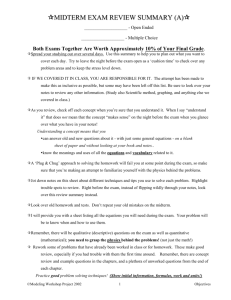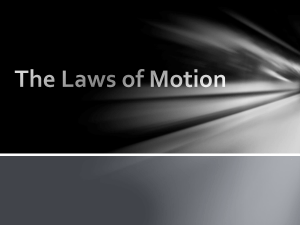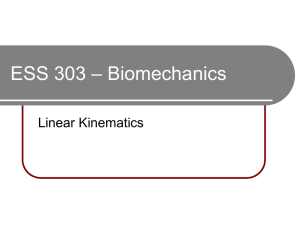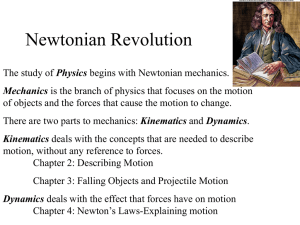What you should know when all is said and done
advertisement
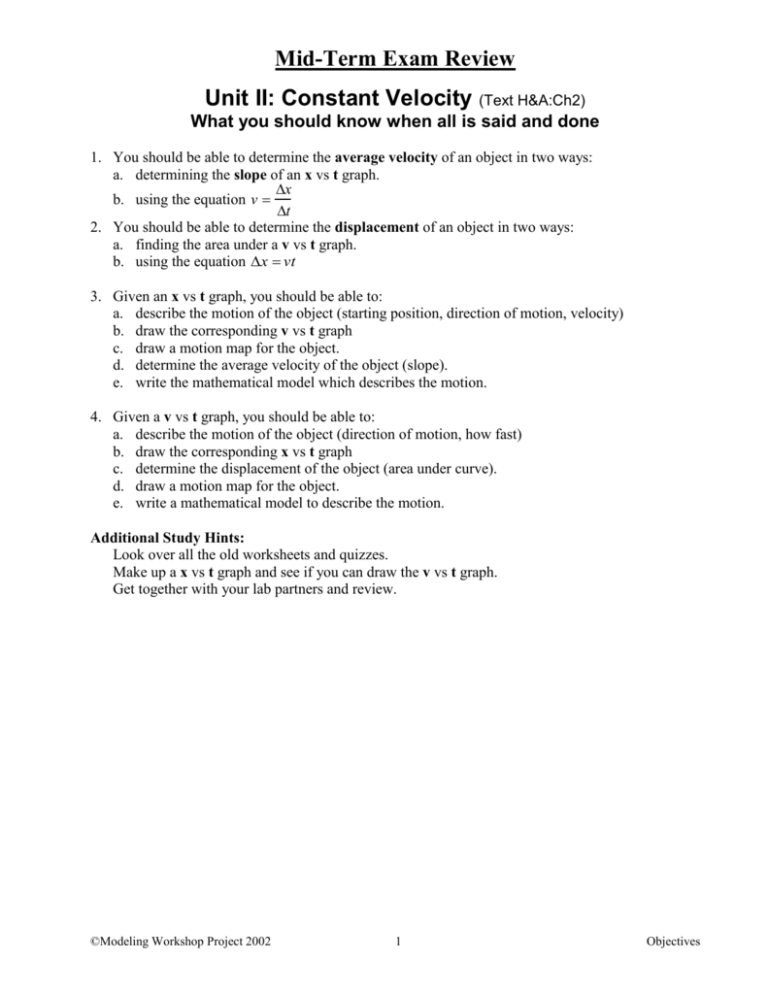
Mid-Term Exam Review Unit II: Constant Velocity (Text H&A:Ch2) What you should know when all is said and done 1. You should be able to determine the average velocity of an object in two ways: a. determining the slope of an x vs t graph. x b. using the equation v t 2. You should be able to determine the displacement of an object in two ways: a. finding the area under a v vs t graph. b. using the equation x vt 3. Given an x vs t graph, you should be able to: a. describe the motion of the object (starting position, direction of motion, velocity) b. draw the corresponding v vs t graph c. draw a motion map for the object. d. determine the average velocity of the object (slope). e. write the mathematical model which describes the motion. 4. Given a v vs t graph, you should be able to: a. describe the motion of the object (direction of motion, how fast) b. draw the corresponding x vs t graph c. determine the displacement of the object (area under curve). d. draw a motion map for the object. e. write a mathematical model to describe the motion. Additional Study Hints: Look over all the old worksheets and quizzes. Make up a x vs t graph and see if you can draw the v vs t graph. Get together with your lab partners and review. ©Modeling Workshop Project 2002 1 Objectives UNIT III: Constant Acceleration (Text H:Ch2, A:Ch3) What you should know when all is said and done 1. You should be able to determine the instantaneous velocity of an object in three ways: a. determining the slope of the tangent to an x vs t graph at a given point. b. using the mathematical model v f at vi c. using the mathematical model v 2f v2i 2ax 2. You should be able to determine the displacement of an object in three ways: a. finding the area under a v vs t curve 2 b. using the mathematical model x 12 at vit c. using the mathematical model 2 2 v f vi 2ax 3. You should be able to determine the acceleration of an object in five ways: a. finding the slope of a v vs t graph v b. using the mathematical model a t 2 c. rearranging the mathematical model x 12 at vit d. rearranging the mathematical model v f at vi 2 2 e. rearranging the mathematical model v f vi 2ax 4. Given a x vs t graph, you should be able to: a. describe the motion of the object (starting position, direction of motion, velocity) b. draw the corresponding v vs t graph c. draw the corresponding a vs t graph d. draw a motion map for the object (including v and a vectors) e. determine the instantaneous velocity of the object at a given time 5. Given a v vs t graph, you should be able to: a. describe the motion of the object (direction of motion, acceleration) b. draw the corresponding x vs t graph c. draw the corresponding a vs t graph d. draw a motion map for the object (including v and a vectors) e. write a mathematical model to describe the motion f. determine the acceleration g. determine the displacement for a given time interval Additionl Study Hints: Look over all the old worksheets and quizzes. Make up a x vs t graph and see if you can draw the v vs t and a vs t graphs. Get together with your lab partners and review. ©Modeling Workshop Project 2002 2 Objectives Unit VI: Free Fall & Projectiles (Text H:Ch2&3, A:Ch3) What you should know when all is said and done By the time you finish all labs, worksheets and related activities, you should be able to: 1. Use video analysis techniques to produce position-time and velocity-time graphs which represent the behavior of an object moving in two dimensions. 2. Determine which model (free or constant force particle model) is appropriate to describe the horizontal and vertical motion of an object. 3. Draw a motion map for an object undergoing parabolic motion, with velocity and acceleration vectors for both dimensions. 4. Draw a force diagram for an object undergoing parabolic motion. 5. Given information about the initial velocity and height of a projectile determine a. the time of flight, b. the point where the projectile lands c. velocity at impact 6. Explain what effect the mass of a projectile has on its time of flight. 7. Use the ULI timer and photogates to determine the initial velocity of a projectile; use this information along with the initial height to determine where the object will strike the ground. ©Modeling Workshop Project 2002 3 Objectives UNIT IV: Newton’s 1st & 3rd Laws (Text H&A:Ch4) What you should know when all is said and done By the time you finish all labs, worksheets and related activities, you should be able to: 1. Describe and give examples of Newton's 1st Law. Newton's 1st Law: An object at rest or moving at constant velocity continues its current motion unless acted upon by an outside agent (force). 2. Given a diagram or a written description of the forces acting on an object: a. draw a force diagram for the object b. resolve the forces into x and y components, then find the vector sum of the forces. c. state whether the velocity of the object is constant or changing. 3. Given a diagram or description of an object in equilibrium, including the forces acting on the object, determine the magnitude and direction of the "missing" force required to keep the object from accelerating. 4. State Newton's 3rd Law; apply it in situations in which you are trying to determine all the forces acting on an object. All forces come in pairs; paired forces are equal in magnitude, opposite in direction and act on separate bodies. FAB = -FBA UNIT V – Newton’s 2nd Law (F=ma) (Text H&A:Ch4) What you should know when all is said and done By the time you finish all labs, worksheets and related activities, you should be able to: 1. Use Newton's 2nd Law to qualitatively describe the relationship between m and a, F and a, m and F. (e.g., if you double the mass, the acceleration will…) 2. Given a v vs t graph, draw the corresponding a vs t and F vs t graphs. 3. Determine the net force acting on an object by: a. drawing a force diagram for an object given a written description of the forces acting on it. b. resolving forces into x and y components, then finding the vector sum of the forces. c. analysis of the kinematic behavior of the object. 4. Solve quantitative problems involving forces, mass and acceleration using Newton's 2nd Law. a. Having determined the net force (as in #3), and given the mass, find the acceleration. b. Continue to use the kinematical models from unit III to determine the velocity or displacement of the object, once the acceleration is known. ©Modeling Workshop Project 2002 4 Objectives
